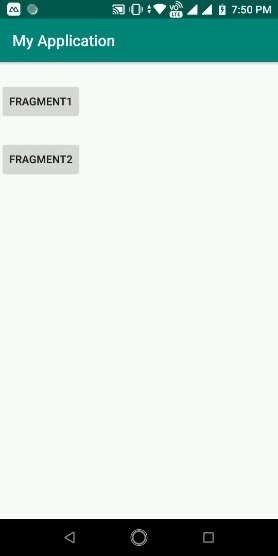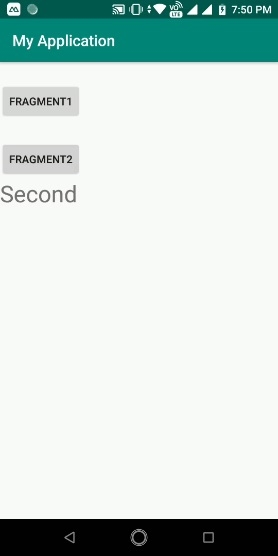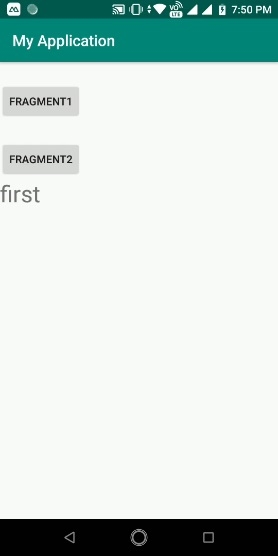
 Data Structure
Data Structure Networking
Networking RDBMS
RDBMS Operating System
Operating System Java
Java MS Excel
MS Excel iOS
iOS HTML
HTML CSS
CSS Android
Android Python
Python C Programming
C Programming C++
C++ C#
C# MongoDB
MongoDB MySQL
MySQL Javascript
Javascript PHP
PHP
- Selected Reading
- UPSC IAS Exams Notes
- Developer's Best Practices
- Questions and Answers
- Effective Resume Writing
- HR Interview Questions
- Computer Glossary
- Who is Who
Fragment Tutorial with Example in Android Studio?
This example demonstrate about Fragment Tutorial with Example in Android Studio
Step 1 − Create a new project in Android Studio, go to File ⇒ New Project and fill all required details to create a new project.
Step 2 − Add the following code to res/layout/activity_main.xml.
<?xml version = "1.0" encoding = "utf-8"?> <LinearLayout xmlns:android = "http://schemas.android.com/apk/res/android" xmlns:app = "http://schemas.android.com/apk/res-auto" xmlns:tools = "http://schemas.android.com/tools" android:layout_width = "match_parent" android:layout_height = "match_parent" tools:context = ".MainActivity" android:orientation = "vertical"> <Button android:id = "@+id/fragment1" android:layout_width = "wrap_content" android:layout_height = "wrap_content" android:layout_alignParentTop = "true" android:layout_centerHorizontal = "true" android:layout_marginTop = "27dp" android:text = "fragment1"/> <Button android:id = "@+id/fragment2" android:layout_width = "wrap_content" android:layout_height = "wrap_content" android:layout_alignParentTop = "true" android:layout_centerHorizontal = "true" android:layout_marginTop = "27dp" android:text = "fragment2"/> <LinearLayout android:id = "@+id/layout" android:layout_width = "wrap_content" android:layout_height = "wrap_content" android:orientation = "vertical"> </LinearLayout> </LinearLayout>
In the above code, we have taken button views and linear layout to show different fragments.
Step 3 − Add the following code to src /MainActivity.java
package com.example.myapplication;
import android.os.Build;
import android.os.Bundle;
import android.support.annotation.RequiresApi;
import android.support.v4.app.FragmentManager;
import android.support.v4.app.FragmentTransaction;
import android.support.v7.app.AppCompatActivity;
import android.view.View;
public class MainActivity extends AppCompatActivity {
@RequiresApi(api = Build.VERSION_CODES.LOLLIPOP)
@Override
protected void onCreate(Bundle savedInstanceState) {
super.onCreate(savedInstanceState);
setContentView(R.layout.activity_main);
final android.support.v4.app.Fragment first = new FirstFragment();
final android.support.v4.app.Fragment second = new SecondFragment();
findViewById(R.id.fragment1).setOnClickListener(new View.OnClickListener() {
@Override
public void onClick(View v) {
android.support.v4.app.FragmentManager fm = getSupportFragmentManager();
android.support.v4.app.FragmentTransaction fragmentTransaction = fm.beginTransaction();
fragmentTransaction.replace(R.id.layout, first);
fragmentTransaction.commit();
}
});
findViewById(R.id.fragment2).setOnClickListener(new View.OnClickListener() {
@Override
public void onClick(View v) {
FragmentManager fm = getSupportFragmentManager();
FragmentTransaction fragmentTransaction = fm.beginTransaction();
fragmentTransaction.replace(R.id.layout, second);
fragmentTransaction.commit();
}
});
}
}
Step 4 − Add the following code to src / FirstFragment.java
package com.example.myapplication;
import android.annotation.SuppressLint;
import android.os.Bundle;
import android.support.annotation.NonNull;
import android.support.annotation.Nullable;
import android.support.v4.app.Fragment;
import android.view.LayoutInflater;
import android.view.View;
import android.view.ViewGroup;
import android.widget.TextView;
@SuppressLint("ValidFragment")
public class FirstFragment extends Fragment {
TextView textView;
@Nullable
@Override
public View onCreateView(@NonNull LayoutInflater inflater, @Nullable ViewGroup container, @Nullable Bundle savedInstanceState) {
View view = inflater.inflate(R.layout.fragment, container, false);
textView = view.findViewById(R.id.text);
textView.setText("first");
return view;
}
}
Step 5 − Add the following code to src / SecondFragment.java
package com.example.myapplication;
import android.annotation.SuppressLint;
import android.os.Bundle;
import android.support.annotation.NonNull;
import android.support.annotation.Nullable;
import android.support.v4.app.Fragment;
import android.view.LayoutInflater;
import android.view.View;
import android.view.ViewGroup;
import android.widget.TextView;
public class SecondFragment extends Fragment {
TextView textView;
@Nullable
@Override
public View onCreateView(@NonNull LayoutInflater inflater, @Nullable ViewGroup container, @Nullable Bundle savedInstanceState) {
View view = inflater.inflate(R.layout.fragment, container, false);
textView = view.findViewById(R.id.text);
textView.setText("Second");
return view;
}
}
Step 6 − Add the following code to res/layout/ fragment.xml.
<?xml version = "1.0" encoding = "utf-8"?> <LinearLayout xmlns:android = "http://schemas.android.com/apk/res/android" android:layout_width = "match_parent" android:gravity = "center" android:layout_height = "match_parent"> <TextView android:id = "@+id/text" android:textSize = "30sp" android:layout_width = "match_parent" android:layout_height = "match_parent" /> </LinearLayout>
Let's try to run your application. I assume you have connected your actual Android Mobile device with your computer. To run the app from android studio, open one of your project's activity files and click Run ![]() icon from the toolbar. Select your mobile device as an option and then check your mobile device which will display your default screen –
icon from the toolbar. Select your mobile device as an option and then check your mobile device which will display your default screen –

Now click on buttons, it will show the result as shown below –


Click here to download the project code

